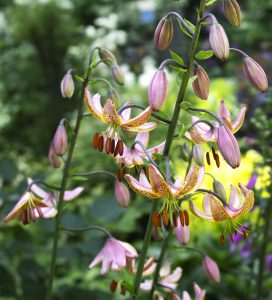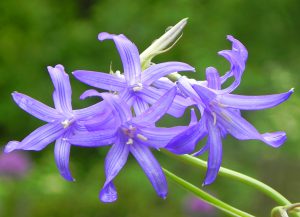Eremurus:
Foxtail lily is the common name for these stately flowers, but they have nothing to do with lilies. They’re one of the most exotic-looking bulbs of summer, emerging like rockets reaching up to four feet tall before unfurling each individual yellow, white, pink or orange floret from bottom to top.
It’s good to plant these brittle, star-shaped roots as soon as they arrive in the mail. Select the planting spot with care because they don’t like to be moved, and they don’t like overplanting or a lot of digging around them. They shouldn’t be transplanted unless absolutely necessary.
The Chicago Botanic Garden suggests digging a 15-inch wide hole six inches deep in the prepared site, and mounding a shallow cone of soil in the center. To improve drainage, add an inch or two of coarse sand before spreading the roots out over the cone. Cover with 4 to 6 inches of soil. Also called Desert Candles, Eremurus grow from 48” to 60” tall, and are hardy from Zones 6-9 (Zone 5 with two inches of protective mulch after the ground freezes.)
Lilium:

‘Guinea Gold’ is a martagon hybrid that might take two years to bloom. It’s worth the wait.
Examples of Lilium include those found at supermarkets around Easter and Mother’s Day. Some grow well above our heads, while others, like the Lily Looks series, just graze our knees. While there are close to 100 species, most of what is commonly available are hybrids, or crosses of two or more species. It’s a win-win, because the hybrids have been bred for disease resistance and increased vigor. I select most lilies for fragrance, but I also prefer the light colored lilies that seem to glow at dusk. While most of my lilies bloom in July, some start as early as peony season. Depending on which species or hybrid, hardiness of Lilium ranges from Zone 3 to Zone 8, so check each individual variety. Here are several I can recommend for Zones 5 and 6. Months listed indicate when they typically begin to bloom.
- ‘Guinea Gold’ (early – mid June)
- ‘Eyeliner’ (early – late June)
- ‘Red Velvet’ (early – mid July)
- ‘Conca d’Or’ (early – mid July)
- ‘Orania’ (early – mid-July)
- ‘Porcelain Doll’ (early – mid-July)
Ixiolirion

A close-up of the flower cluster of Ixiolirion.
If plants were as difficult to grow as their names are to pronounce, gardens certainly would be limited. Ixiolirion tataricum ssp pallasii has a couple of common names, including Siberian Lily or Tartar Lily, and is native to the steppes of Asia minor, Afghanistan and Syria. It’s incredibly hardy if planted in a sunny, well-drained spot, makes a great companion to peonies, and lasts several days as a cut flower.
Plant Ixiolirion (pronounced ICKS–e– o– LEER–eon) in groups, because each plant is rather wispy. Each individual stem reaches about 18” tall and is topped with a cluster of lavender blooms. It stands up without support, especially if planted in a sunny spot.
Ixiolirion are short-lived, meaning they will thrive in a good location in Zone 6 or colder for a few years before petering out. Mine lasted five years, but they are inexpensive to purchase. You can purchase them at John Scheepers in Bantam, CT.








